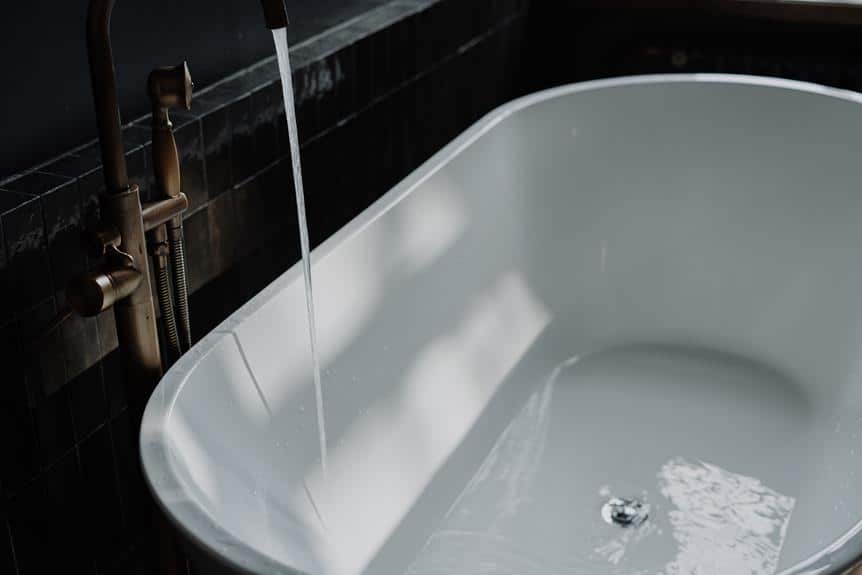The standard height for a bathtub faucet is between 12 to 18 inches above the rim of the bathtub. The spout should be about 4 inches higher to prevent backflow. This height range allows for good water pressure and less splashing.
It typically fits well with existing plumbing, avoiding major changes. Make sure to consider the type of bathtub and any shower attachments to choose the best faucet height for comfort and accessibility.
Following these installation guidelines helps ensure a good bathing experience.
Understanding Standard Heights
The standard height for a bathtub faucet is 12 to 18 inches above the tub rim, complying with building codes to prevent backflow and accommodating different water pressure levels from water heaters. Faucet height also reduces splashing and provides ease of access.
For different bathtub types like freestanding and alcove, faucet placement requirements may vary. The spout is usually 4 inches above the tub rim to meet building codes and address water pressure concerns that could cause splashing or access difficulties.
The chosen height enhances user comfort and functionality, ensuring a pleasant bathing experience without water spillage. Installation or replacement of a faucet should involve high-quality waterproof silicone caulking to ensure a watertight seal and extend the longevity of the fixtures.
Assessing Tub Types and Styles
When choosing the height for a bathtub faucet, it is important to consider the type and style of the tub. The location of the faucet impacts both the look and functionality and must adhere to plumbing codes.
For a freestanding tub, the faucet typically stands on the floor about six inches from the tub's edge for efficient filling and to prevent splashing.
For an alcove or built-in tub, the faucet is usually wall-mounted 4 to 18 inches above the rim to ensure good water flow and avoid backflow. The positioning of the supply lines is critical for the faucet to function correctly.
The bathtub style also affects faucet placement. Modern tubs might need a simple faucet design placed precisely for optimal water flow, while traditional claw-foot tubs might require higher, vintage-style faucets for aesthetics and functionality.
Plumbing must be planned to support the chosen faucet height, fitting the tub's type and style while fulfilling functional needs. Proper evaluation of tub types and styles is essential for the correct installation of bathtub faucets.
Importance of Building Codes
Building codes require that bathtub faucets are installed in a way that is functional, safe, and compliant with local regulations to avoid water damage and ensure user safety. These codes establish a minimum air gap of at least 2 inches between the faucet spout and the tub rim to prevent backflow and protect water quality.
The placement of the faucet also affects the bathtub's usability, as codes consider the ideal position for efficient drainage and reduced splashing. Expert plumbing advice often highlights the importance of following these codes to ensure a proper water supply connection and ease of use for different individuals.
Additionally, building codes take into account the variety of bathtub styles and the limitations of existing plumbing systems. By setting specific requirements for faucet height and position, these rules help ensure that bathtubs function well without sacrificing design or user experience.
Following building codes is essential for the durability and safety of bathroom installations and for the comfort of users.
Personal Comfort Considerations
Personal comfort is essential when deciding the height of a bathtub faucet. The faucet should be high enough to prevent awkward movements but not so high that it splashes water outside the tub.
The standard height balances accessibility and design, yet individual needs are paramount. The spout should be at least 2 inches above the tub rim to prevent splashing and should match the bathtub's size to avoid discomfort.
Each user's requirements should dictate the faucet's height and reach. The optimal setup is functional, cost-effective, and comfortable. Considering these factors will enhance the bathing experience.
Incorporating Shower Attachments
When installing shower attachments to a bathtub, it's important to place the faucet at the correct height, following local building regulations. For new bathtubs, especially freestanding ones, the faucet is typically installed about four feet from the tub floor, though this may vary with faucet types and tub designs.
For adding hand showers to existing bathtubs, install the faucet at least two inches above the tub rim to meet most building codes. This ensures the attachment can connect to the water system properly.
Professional help is often needed when installing a new showerhead, especially if it requires rerouting plumbing and opening walls. If the shower is separate from the tub, the controls should be placed 38 to 48 inches from the floor for ease of use and accessibility.
The precise height for faucet installation can vary based on personal needs and the shower attachments used. Above all, adherence to local building codes is crucial for safety and functionality. Considering these guidelines helps homeowners create an effective and visually appealing bathroom.
Installation Best Practices
For a bathtub faucet, install it 12 to 18 inches above the tub rim to allow for clearance and easy connection to water supply lines. Place tub fillers near the drain for efficient filling and drainage. Ensure the faucet extends at least two inches from the wall to prevent water damage.
For enclosed tubs, center the faucet for a balanced look. In a shower/bath combo, position the handle between the showerhead and tub spout for accessibility.
These practices ensure proper installation, safety, and ease of maintenance.




